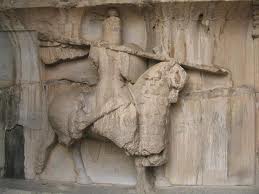|
Heraclius, eastern roman emperor, who recognised and strengthened the imperial administration and the imperial armies at about the age of 35, was sent to Constantinople by his father, the governor of the Roman province of Africa, to deal with the crisis precipitated by the incompetent emperor Phocas. Upon his arrival he deposed Phocas, thus inheriting an Empire in shambles.

Even though Heraclonas was co-emperor, his young age and inexperience allowed Martina(second wife) to control him totally and thus rule the state through Heraclonas. She constantly opposed the policies of Heraclius Constantine(son), and this opposition led to the development of two factions within the government.
While Heraclius Constantine possessed the more powerful following, the worsening economic situation in Constantinople and his failure to prevent the Arabs from seizing Egypt weakened him politically. His sudden death of tuberculosis in late April or early May (April 20/24 or May 26), less than four months after assuming power, left Heraclonas as sole ruler. Martina, still working through Heraclonas, began immediately to exile the prominent supporters of Heraclius Constantine.

When Heraclius first came to the throne in 610, the Byzantine Empire was being attacked from numerous sides. In the west, the Avars and Slavs were expanding into the northern Balkans. The Slavs controlled the Danube regions, Thrace, Macedonia, and were soon invading Central Greece and the Peloponnesus. In the east, meanwhile, the Persians under the rule of Chosroes had begun a series of successful attacks on the empire resulting in the loss of Damascus in 613, Jerusalem in 614 (destroying the Church of the Holy Sepulchre and capturing the Holy Cross) and Egypt in 619.

Heraclius sat to work by first strengthening the defenses of the Empire. He divided the land into four Themes (military districts), each ruled by a military governor. By giving prospective soldiers land grants, he recruited a considerable number of native fighters. No longer was Byzantium to rely on foreign mercenaries.
The later years of Heraclius were marked by the Arab Invasion. The army had not yet recovered from the Persian wars and the population of Palestine and Egypt were unhappy (due to the taxes) and this favoured the Arabs, who crushed the Byzantine army at the Battle of Yarmouk, taking all of Syria-Palestine and Egypt. Heraclius died in 641 after a great reign and was succeeded by his son Constantine III Heraclius who died in the same year.
|

![]()


